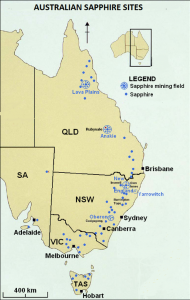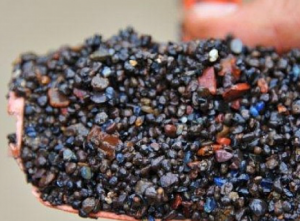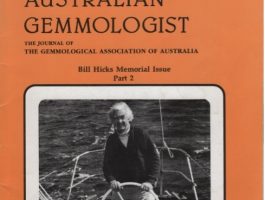AG Article: Update on Australian Sapphires
Title: Update on Australian Sapphires
Authors: Ian T Graham1*, Nicholas Raffan1, Ralph Bottrill2, David McP. Duncan3, William D. Birch4, Peter J. Downes5, Susan M. Stocklmayer6, Gaston Giuliani7
1 School of Biological, Earth and Environmental Sciences, University of New South Wales, Kensington, Sydney, NSW 2052, Australia.
2 Mineral Resources Tasmania, PO Box 56, Rosny Park, Tasmania, 7018, Australia
3 McPherson Duncan and Associates, Kingston, Tasmania, 7050, Australia
4 Geosciences, Museums Victoria, GPO Box 666, Melbourne, Victoria 3001, Australia
5 Western Australian Museum, 49 Kew Street, Welshpool, Western Australia 6106, Australia
6 Lesmurdie, Perth, Western Australia
7 CRPG-CNRS, Nancy, France
*i.graham@unsw.edu.au
Abstract: Most sapphire fields in Australia occur along its eastern margin from Tasmania in the south to far north Queensland in the north. These deposits are associated with widespread Cenozoic intraplate alkaline basaltic magmatism which carried the sapphires to the surface as xenocrysts. Concentrations of these sapphires are derived from the weathering and erosion of the basaltic volcanics and occur in present-day alluvial and palaeoalluvial deposits with most commercial mining of the latter. The sapphires are intimately associated with other resistate xenocrysts including zircons, spinels and rare diamonds. Although various shades of blue, green and yellow (BGY suite) are dominant, fancy-coloured orange, pink, purple and red sapphires also occur. The New England region of northern New South Wales has been highly productive for over 50 years and commercial mining still occurs at Kings Plains. Other major occurrences in New South Wales include the Barrington Tops and Gloucester Tops fields, Yarrowitch and Tumbarumba. In Queensland, by far the most active commercial field is the Anakie field in central Queensland which has been exploited for over 100 years. This field produces amongst the world’s best large deep blue, golden yellow and parti-coloured sapphires. The Lava Plains field in far northeastern Queensland is the youngest sapphire field in Australia and mainly produces deep blue sapphires with minor yellow, green and fancy-coloured pink stones. Tasmania has numerous occurrences, with many sapphires found during alluvial tin mining of Cenozoic sediments in the late 1800’s. Most are blue in colour but a wide range of colours occurs, including fancy-coloured pink and purple sapphires. A range of geological sources is likely for the Tasmanian sapphires. In Victoria, sapphires are widespread within present-day alluvial and palaeoalluvial deposits though most of the stones are of small size. Once again, blue sapphires are predominant, though a wide range of fancy-coloured sapphires have also been found. Many of the occurrences were discovered during the late 19th century alluvial gold rushes. Unlike in the eastern states, deposits of blue, grey and pink-purple corundums in Western Australia are largely associated with Archean to Proterozoic high-grade metamorphic rocks. Some of these make large cabochons and decorative stones and occur in crystals up to 11.2 kilograms and masses up to 40 kilograms. Research into the localised characteristics and origin of Australian sapphires is ongoing.

Figure 1. Map showing the distribution of sapphire fields in eastern Australia with the principal mining centres of New England (New South Wales), Anakie and Lava Plains (Queensland) circled. Adapted from Sutherland et al. (2016).

Figure 3. Rough gem concentrate from Kings Plains. Photo courtesy of John Wilson, Kings Plains sapphires.
Read the full article in the December 2020 Issue of the Australian Gemmologist. Members of the Gemmological Associate receive copies of the journal free of charge – find out more about becoming a member today. Need a copy of the issue? Please contact the Editor.




